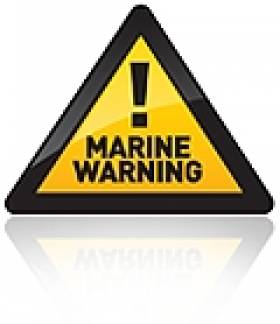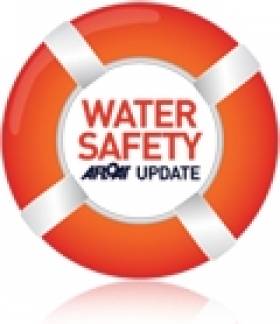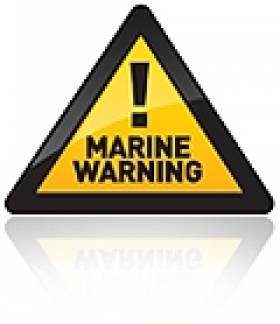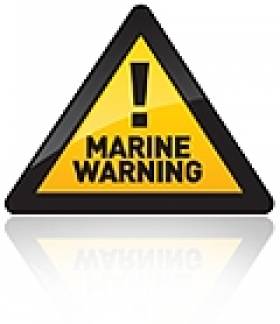Displaying items by tag: Irish Water Safety
Marine Warning – Gales Put Lives in Danger
#iws – The Chief Executive, of Irish Water Safety, John Leech is warning the public of the increased risk to drowning around our coastline for the next few days. 10% of all recorded drowning in Ireland are as a result of people walking close to the waters edge.
The combination of high tides as a result of the Full Moon on Sunday, low pressure out in the Atlantic and Gale Force winds makes walking along our coastline particularly dangerous today and for the next day or so. Our Estuaries and rivers are also hazardous due to the high levels of rainfall in the last few days and the rain forecast for the remainder of the week.
We recommend that walker's who normally walk along our coastline, promenades, piers and rivers should use an inland alternative away from water for the early part of this week, until the weather and tidal conditions improve to make it a safer environment.
Flood conditions expose the public to hazards they need to be aware of. Fast moving water can exert pressure of up to four times its speed against the legs of someone attempting to cross it. Because water displaces bodyweight, the deeper a person becomes immersed the less the person weighs so the more difficult it is to remain upright. Never put ones feet down if swept away in floodwater, because foot and body entrapments and pinning are the leading cause of accidental death in rivers and fast flowing water.
Motorists need to be vigilant to avoid flooded areas on roads but particularly near rivers; with poor light and short days it is not possible to determine the depth of floods easily. Swift water will carry cars and other vehicles away and there have been very tragic drownings in the past as a result.
Children are naturally curious about water, therefore parents should caution them that floodwater hides the true depth and that manhole covers may be open and that small streams when swollen are very fast and deeper than normal.
Personal Safety
Avoid flood waters at all times
carry a mobile phone at all times in case you need to call for help - call 112 in emergency
Wear suitable protective clothing & a lifejacket on or around water
Do not enter fast flowing water.
Never put your feet down if swept away by fast flowing waters
Flooding on roads will be deeper at dips and around bridges.
Stay away from sea and flood defences.
when walking or driving, be aware of manhole covers and gratings that may have been moved due to the heavy flow of water.
Take care when using electric appliances in damp or flood conditions.
Remember that during the hours of darkness the dangers are multiplied.
What should I do when I hear a Flood Warning?
Listen to the national and local radio for Met Eireann updates and AA Road watch updates
Check on neighbours particularly if they are elderly, infirmed or families with young children
Move your vehicles to higher ground
Move animal stock to higher ground
Check your small craft to ensure they are well secured or moored
Make sure you have warm clothes, food, drink, a torch and radio.
Block doorways and airbricks with sandbags or plastic bags filled with earth. Floodgate products will also work effectively.
Switch off gas and electricity supplies if flooding is imminent.
Check the time of High Water in the Newspaper or on http://easytide.ukho.gov.uk/EASYTIDE/EasyTide/SelectPort.aspx
Check out www.flooding.ie for more detail on General flooding
After the flood
Avoid eating food that has been in contact with flood water.
Run water for a few minutes and wash your taps.
Check gas and electricity supply.
Leave wet electrical equipment alone to dry and have it checked prior to use.
Ventilate your property well.
Check on elderly neighbours.
Thirty-Six Lives Saved in Near-Drowning Rescues
#irishwatersafety – Twenty-six rescuers from twenty-two dramatic near-death incidents will receive recognition at Irish Water Safety's National Awards Ceremony at City Hall, Dublin on Tuesday 27th November 2012, from 3pm to 5pm. Thirty-six lives were saved through the brave actions of these rescuers.
Mr John Perry TD, Minister of State at the Department of Jobs, Enterprise and Innovation will present the "SEIKO Just in Time Rescue Award" to these rescuers in appreciation for saving so many lives.
"Tragically an average of 140 drownings occur in Ireland every year," commented Minister Perry, "and although that's 140 too many, the figure would be even higher but for the dramatic efforts of these individuals who saved others from drowning and the ongoing work of volunteers teaching swimming and rescue skills."
"Last year, the 128 drownings in Ireland were lower than the annual average, reason enough to be confident that the work of Irish Water Safety Volunteers and partners in the public and private sector is having the desired outcome - more people enjoying our wonderful aquatic facilities more safely. That said complacency is not an option", he added.
"I appeal to all adults to make themselves more aware of the dangers in, on and around water", continued Minister Perry. "It only takes seconds for tragedy to strike and this can so easily be avoided if people take responsibility for their own safety by learning about the hazards. I ask that people encourage friends and family to read Irish Water Safety's guidelines at www.iws.ie so that they don't become a drowning statistic."
Service Awards will also be presented, recognising 795 years of personal service of 43 Irish Water Safety volunteers from around the country for teaching swimming, rescue and water survival skills.
SEIKO JUST IN TIME AWARD RECIPIENTS:
Co. Clare
Ms Eve Copley, Ms Ellen McMahon, Ms Aisling O'Sullivan
On the evening of Tuesday the 12th June 2012, three friends, Aisling, Eve and Ellen, were walking home from town when they noticed a woman in distress at the edge of the River Fergus, trying to retrieve her dog by calling to him. The woman entered the water and soon got into difficulty due to the strong current. Without hesitation the three friends quickly raced to the aid of the woman. They got the lifebuoy that was located at Steels Rock, Lifford town and threw it towards the woman who grabbed hold of it and they pulled her in towards them to safety. Thanks to the quick thinking and actions of these three friends a drowning was prevented.
Co Cork
Ms Bebhinn Crowley
Sunday 7th October 2012, The Munster School championships took place at UL. Fifteen year old Bebhinn came to the rescue of her friend. During a 100m final, a female competitor collapsed, having completed the race. It was the observation and quick response of Bebhinn that resulted in the rescue of this student.
Co Cork
Mr Karl Fitzgerald
On Saturday 25th August 2012, the Fitzgerald family were at Chimney Cove, West Cork. Karl's parents entered the water and they were wading until the current pulled them out of their depth. They tried to swim back to shore but the force of the current was too strong. Karl immediately made his way down along the rocks towards them. He entered the water and rescued his mother first. Once she was safe, he assisted his cousin Michael in rescuing his father. If it were not for the quick thinking and actions of Karl, this incident may have ended in tragedy.
Co Donegal
Mr Jason McClay
Around midnight, on the 2nd June 2012, a car had left the road, careered fifty yards through a field and went off a steep drop into the Crana river near Buncranna. Nineteen year old Jason McClay from Kinnego, had been at a friend's house when he heard the screeching of tyres followed by a loud bang. He left the house and ran down through a field and saw that a car was submerged in the water. Without hesitation, Jason jumped off the 40 ft Ravine. Upon entering the water he noticed a girl who had managed to escape out of the car. Jason swam in through the car window. Visibility was poor as it was very dark and he could not see anyone else in the car. On leaving the car, he noticed a boy and dragged him over to the bank. He then went back and got another boy out and dragged him to safety. There were four passengers in total, all teenagers. Only two were swimmers. Emergency services arrived to the scene. Due to the quick thinking and selfless courage of Jason's actions, four lives were saved.
Co Donegal
Mr Patrick Moss
On the afternoon of the 27th of December 2011, twenty year old Patrick Moss was taking a walk along the Rosbeg pier when he saw a car enter the water. He assessed the situation and ran to the shore where he entered the water and swam out towards the car which was sinking. He grabbed onto the driver of the car and took her to safety. He placed her into the recovery position until the emergency services arrived.
Dublin
Mr Daragh Lavelle, Mr Kevin Barry
DublinOn the 25th May 2012, at the 40 foot, Sandycove, Dun Laoghaire, Kevin Barry was taking his regular swim when he heard a male shouting for help. He observed two males in trouble in the water. Without hesitation, Kevin immediately swam to one struggling male, placed his arm around him and brought him to safety. On hearing shouts for help, Daragh entered the water and swam 200 meters out to assist Kevin with the rescue of the other male. He checked the male once at the shore and placed him into the recovery position.
Galway
Mr Ian Brennan
On Sunday 7th October 2012, Ian Brennan, a duty manager at Leisureland, Galway, was at work when a call came to reception saying that a person was in difficulty in the water at Salthill. Without hesitation, Ian grabbed a ringbuoy and went to the scene. He entered the water and swam out to the man. He held onto the man until the Galway Lifeboat reached them both. The man was suffering from hypothermia and was taken to hospital where he made a full recovery.
Monaghan
Garda John Callahan
On the 30th August 2010, Garda John Callahan responded to a call at Lough Muckno, Castleblaney, Co Monaghan. He observed a young girl in distress in the water. Without hesitation, Garda Callahan swam to her aid but as he approached the girl, she disappeared under water. Garda Callahan dived under water and brought her to the surface and safely back to shore. The girl made a full recovery.
Laois
Mr Colin Lawlor
On the afternoon of the 17th August 2011, at Johns Bridge, on the River Nore, Kilkenny, Colin Lawlor was out running along the riverbank when he noticed a person in distress in the water. He instructed two passersby to call the emergency services. Without any hesitation he grabbed a lifebuoy and then entered the water. The person was tiring and had gone under the water a few times. As he went under again Colin grabbed his wrist and carried him to the bank. Emergency Services arrived and commenced first aid. He made a full recovery.
Meath
Mr Brian McLaren
At approximately 6pm on the 12th August 2012 at Mornington Beach, five children were playing in the waves when a riptide swept them out of their depth and they got into difficulty. Brian McLaren observed the children and asked his partner to phone emergency service before entering the water. He swam fifty meters to the children and encouraged four of the children to swim to rocks. He then swam out to the youngest child and upon reaching him he managed to bring him to the breakwater to safety and onto rocks where he performed CPR. Brian had also drawn the attention of a group of people on Jet Skis. He instructed the Jet Skier to help him remove the child to the shore. Brian and other members of the public helped carry the other four children off the breakwater to the safety of the shore. All children made a full recovery.
Westmeath
Mr Jack Donohue
At approximately 11pm on the 5th July 2012 a car crashed and plunged into Coosan Point, Athlone. When Jack Donohue arrived at the scene he grabbed a lifebuoy and entered the water. He reached the car and opened the door and put the lifebuoy around the driver and pulled him out of the car and took him to safety where emergency services were waiting. The man made a full recovery.
Wexford
Mr John Ross, Mr Fergie Kehoe
On the 10th March 2012 a female got into difficulty at Commercial Quay, Wexford. Without any hesitation John Ross and Fergie Kehoe came to the rescue of the woman. They lowered themselves onto a raft and upon reaching the woman John Ross placed a lifebuoy around her and pulled her up onto the raft and took her to safety. The Woman made a full recovery.
Wicklow
Mr Gus Cooney, Ms Deirdre Fitzgerald
On Saturday 26th May 2012, Gus Cooney observed a man had got into difficulty at Glen Strand, Wicklow. Without any hesitation Gus entered the water and with the aid of Deirdre Fitzgerald brought the man to safety. The man made a full recovery.
Wicklow
Ms Beverly Dunne, Ms Lorraine Hamm, Mr Arthur Muizininks, Mr Demitri Agurazov, Mr Norman Kudla.
On the evening of the 10th of August 2012 at Brittas Bay North beach, a ten year old boy was playing with other children at a sand dune when it collapsed suddenly, burying the boy. Friends Beverly Dunne and Lorraine Hann were packing up with their families when their attention was drawn to the area by a boy in distress. It became evident that there was someone trapped. Lorraine telephoned the emergency services. Meanwhile, three friends, Arthur, Demitri and Norman immediately began digging. After approximately twelve minutes they pulled the boy to safety. He began breathing and was taken away by ambulance. He made a full recovery.
Donegal
Mr PJ Patton (posthumous award), Mr Larry McGonigle (posthumous award), Mr John Patton, Mr Hugh-John McGonigle
In June of 1955, two men from Ballyshannon set out to bring up their fishing punt, which they had anchored the previous evening. One of the men, Mr McCusker, waded out to it, but he suddenly found himself out of his depth. He tried to swim against the strong current but he could not, his friend tried to reach him but it was too dangerous.
Mr McCusker found himself sucked down by the swirling water yet he continued swimming until he broke the surface. He tried to swim towards the "Black Rock" but was taken by the current again. He spotted an old boat wreck and he managed to grasp it and pull himself up. It was extremely cold. He saw men in the distance and waved. He could feel his feet go numb and he knew he had to try to get his circulation back. Four young men, John Patton now age 78, Larry McGonigle R.I.P., Hugh John McGonigle age 78 and P.J. Patton R.I.P., went to the rescue of Mr McCusker. Upon assessing the situation they got a boat and went out into the channel where the water was bubbling up around them. They dropped an anchor and then let the boat out on a rope trying to get close to the wreck. It took them four attempts before they managed to reach Mr McCusker and eventually managed to get him into the boat. The rescue took over one hour.
Co Clare
Mr Paddy Casey, Mr Peter Downes (posthumous award)
Paddy Casey now 85 years of age, was involved in many rescues during the 1940's, 50's and 60's. Paddy was one of the first officially appointed lifeguards in Ireland at a time when training and equipment were few or non-existent. Support services were scarce and communication was limited to written and word of mouth. Lifeguards were on their own and reliant on their own skills and knowledge. Paddy was one of the first members of the Clare Swimming and Life Saving Association.
Paddy was appointed Lifeguard in 1943. Also appointed was Mr Peter Downes. Together they prevented loss of life due to drowning in their years as lifeguards.
On 15th July 1944, Paddy was patrolling Spanish Point beach when he noticed a woman in distress in the water. He immediately reacted and swam to her aid and succeeded in bringing her safely ashore. He was assisted by Peter Downes at the later stages of the rescue.
On the 14th August 1949, at Spanish Point beach, three people got into difficulty. Peter Downes swam to their assistance, The second lifeguard Paddy, observed his companion and rushed to their assistance. After fighting his way through waves which reached 4-5 feet in height, Paddy brought one of the female swimmers to safety and returned to the water to retrieve a male swimmer. Paddy then entered the water for a third time in search of Peter and the third person who had by now drifted seawards. Both lifeguards took the lady to safety and performed CPR on her and thankfully she recovered well.
In September of 1955, at Spanish Point, despite the warning given to a male swimmer regarding poor bathing conditions, the swimmer entered the water and got into difficulty. Without hesitation Paddy entered the water and succeeded in bringing the exhausted swimmer to safety.
In August 1955, 2 female swimmers got into difficulty at Spanish Point. Both lifeguards Peter Downes and Paddy Casey went to their assistance and brought them to safety.
In July 1956, two students found themselves in danger after they ventured too far out to sea. Again both lifeguards, Paddy Casey and Peter Downes, were to hand and brought the two female students to safety.
In 1957, four young students entered the water at Spanish Point despite having been warned of the dangers of bathing that day. The students got into difficulty and both Paddy and Peter decided that the only safe way to rescue them, due to the inclement conditions, was to take a line either side of them. They entered the water and instructed the four young men to swim to the line and hold on, which they did, and with the help of the lifeguards they were then able to wade to shore.
In 1969 while standing on a cliff overlooking the beach at Spanish Point early one morning, Paddy Casey observed a young woman had got into difficulty in water, her husband a non-swimmer was calling for help. Without hesitation, Paddy entered the water and swam to her and brought her to safety.
From 1944-1962 Fifteen lives were saved - Paddy Casey saved ten lives and Mr Peter Downes R.I.P. saved five lives.
Irish Water Safety Issues Bank Holiday Warning
#watersafety – Water-related tragedies can happen in seconds and in the wake of 128 drownings last year, Irish Water Safety is drawing attention to the dangers that will put people's lives at risk this coming Bank Holiday weekend.
Dry, crisp weather will prompt people to enjoy activities near water however the air temperature will be considerably colder due to a returning polar air mass meaning people need to dress appropriately for their specific aquatic activity. The dry weather also makes for ideal walking conditions however there is a higher risk of being cut off from shore on coastal walks because the tidal range will be significant due to the Bank Holiday full moon and associated spring tides. There is a risk of cold shock due to sudden immersion in water and of hypothermia due to prolonged immersion, therefore some basic measures, if heeded, will avoid needless tragedies this weekend.
A danger foreseen is avoided...
Walkers should remain alert and stay well away from the edge of ordinarily familiar waterside pathways due to the risk of riverbanks crumbling away or beach walk stranding. These walks will be all the more hazardous due to shorter daylight hours and relatively large tides. Please carry your mobile phone and ideally in the company of others.
Anglers will be at risk and foreign nationals in particular should be extremely vigilant as the Atlantic swell is dramatically different to that experienced on the relatively calmer Baltic Sea. Never fish without your lifejacket.
Those boating should ensure that their family and friends wear a lifejacket at all times.
Alcohol should be avoided before or during any aquatic activity. Over 30% of drowning victims had consumed alcohol therefore it is best left until after your activity to celebrate the holiday weekend.
Forty children aged fourteen and under drowned in the last ten years, therefore it is essential that kids are constantly supervised when on or near water.
Lifeboat Design, Foam in Aberdeen, and International Maritime Stories
KEEPING A LIFEBOAT UNDER WRAPS
Keeping a lifeboat design under wraps is some achievement, but that's what an Irishman did with the design for the first RNLI lifeboat to be named after an Irish river. In fact, at the age of 24 he designed the hull form in his spare time!
Four years after his original design, the Shannon class was introduced to public view this week at RNLI headquarters.
Peter Eyre, from Derry, could take justifiable pride because he is an RNLI Naval Architect.
'I kept the design under wraps in the early stages. After a while my boss could see I was working on something and encouraged me to continue. My job was to find the design by working with other naval architects, not to design it. I was the youngest in the team and before long I had designed the new lifeboat hull.
I'm chuffed it was named after an Irish river and the strong connection the boat now has with Ireland. I think the moment it first goes out on a service will be the high point of my career. It's a great legacy to be a part of. When the first life is saved I think that's when it will really hit home.'
Peter has a strong commitment to the RNLI, ever since he was just 14-years-old and the family's 30ft. cruiser racer yacht was dismasted in rough seas and Force 7 winds.
"We were escorted back to shore by the volunteer lifeboat crew. We were so relieved," he recalls.
This is the first time that the RNLI has named a class of lifeboat after an Irish rive.
"It is very fitting considering that Peter has been so fundamental in its design," said Owen Medland, RNLI Training Divisional Inspector for Ireland. "All of the crews who have tested the new lifeboat have been thrilled with its speed, manoeuvrability and the improved crew safety features. We don't know yet which Irish lifeboat stations will receive a Shannon class lifeboat, but the Shannon is designed to replace the majority of Mersey and some Tyne class lifeboats. We look forward to seeing the Shannon here in the near future.'
UK stations will be the first to get the new boat for which the RNLI has launched a €6m. fundraising campaign across the UK and Ireland.
• To make a donation visit: www.rnli.org/newlifeboatappeal
NEW FACE OF ABERDEEN
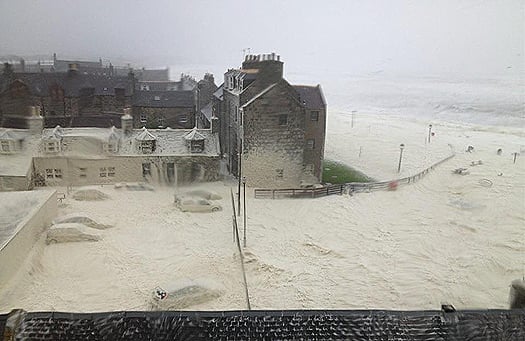
The amount of foam which swept into Aberdeen in Scotland from the gales that hit the UK and caused a lot of flooding during the week was astonishing.
As the photograph here shows, it looks like the area close to the seashore was covered in snow.
Capt.Rowan MacSweeney, my son, is serving on offshore oil rig supply work at present and told me:
"Monday night was a lively night about these parts. We were 4.5nm out from Aberdeen breakwaters because the port closed. Top gust on our anenometer 70 knots and we got swells of 13metres in the bay. Check out the photo one of the lads I know from another boat took the morning after of the foam created by the storm. Pretty unusual."
Indeed it is.
RULING ENDS 'DARK AGES'
{youtube}MbjC9SMKClE{/youtube}
The tanker Exxon Valdez which became notorious after spilling 750,000 barrels of oil into Prince William Sound in Alaska on March 24, 1989, is to be broken-up on Alang Beach in India following assurances given to India's highest court that it would not contain hazardous substances. This was needed after the Court made a ruling which environmentalists have hailed as ending the 'dark ages' of breaking up ships containing hazardous materials on beaches. There have been increasing protests about this practice because of the health, safety and environmental risks involved, particularly for low-paid workers without protection equipment. The Court ruled that vessels sent for shipbreaking will be subject to international rules based on the Basel Convention about hazardous wastes, meaning that shipowners will in future have to remove these materials before the ships are approved for breaking-up on Indian beaches.
FIRST NORWEGIAN CRUISE
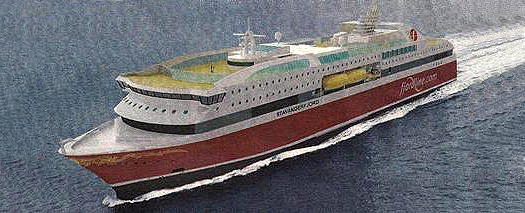
The first cruise direct from Cork to Norway has been announced. Lee Travel and Royal Caribbean International will run two 12-day cruises on June 3 and September 9 next year aboard the Independence of the Seas departing from Cork Port's cruise terminal at Cobh. There will be a capacity for 200 passengers to join in Cork Harbour, according to Lee Travel with prices from €1,699 per person, based on 2 adults sharing an inside stateroom. Fly/Cruise price includes flights back to Dublin/Cork. The Norwegian cruises will take in fjords, glacial inlets, castles, the Norwegian countryside and Oslo.
Declan O Connell, Managing Director of Lee Travel, said there is a demand for such a service from Cork. "We are confident that these cruises will be popular and that Royal Caribbean will sail more ships out of Cobh for many years to come."
GAS FERRIES
Norway is also to the fore in another cruise ship development. The first cruise ferries in the world to be powered by natural gas are under construction in a Bergen shipyard for the Norwegian shipping company, Fjord Line. They will be 170-metres long, powered by Rolls Royce LNG-based engines. The company says they will be the most environmentally-friendly cruise ships on the seas, the first to begin sailing next May out of Bergen in Norway and the second a few months later.
WORK-RELATED DROWNINGS
The Irish Water Safety Association has recorded 22 work-related drownings in the Republic in the past five years of which 17 were in fishing, 1 while transporting freight over water, 1 each in quarrying and construction and 2 in agriculture. The figures were released this week, coinciding with the National Ploughing Championships and following the tragic Northern Ireland drownings in the farm slurry tank, as a reminder that safety is needed at all times. The Association has also pointed out that children are naturally curious about water: "Each year too many young children are involved in preventable aquatic accidents - forty children have drowned in the last ten years."
FIRST MAN TO WALK ON THE MOON BURIED AT SEA
The first man to walk on the moon has been buried at sea. NASA said Neil Armstrong's cremated remains were buried in the Atlantic Ocean during a ceremony aboard the USS Philippine Sea. The space agency didn't give the location of the ceremony. The ship's homeport is Mayport, Florida. Neil
Armstrong was a Navy fighter pilot before joining the space programme. He died in Ohio in August at the age of 82. His burial followed at sea followed a memorial service in Washington.
RUSSIAN SPECIAL
The Russian Navy is to build a new type of search-and-rescue ship which will be launched in 2014. It will have submersible rescue vessels aboard. This is because of the number of Russian submarines which have got into difficulties in past years.
CHINESE FIRST
China's first aircraft carrier has entered service. The 300m (990ft) Liaoning - named after the province where it was refitted - is a refurbished Soviet ship purchased from Ukraine. the carrier has no operational aircraft and will be used for training. The Chinese Government said the vessel, which has undergone extensive sea trials, will increase its capacity to defend State interests.
TANKER DESTROYED COMMANDER
The Commander of a U.S. Navy destroyer was removed from command after his vessel was involved in a collision. The USS Porter was operating near the Straits of Hormuz when struck on its starboard side by the 300,000-tonne tanker Otowasan. Nobody was hurt in the incident .The tanker suffered only superficial damage, but the destroyer was severely damaged according to reports and sailed to the United Arab Emirates for repairs. The destroyer's Commander, Martin Arriola, was removed from command there and replaced.
MAIDEN GROUNDING
A cargo ship has ran aground on its maiden voyage from Southampton to the Channel Islands. The 295ft. £8.8m Huelin Renouf Dispatch hit an isolated rock one and a half miles south-west of Alderney and issued a distress cal, responded to by the RNLI Roy Barker One which was on the scene within 15 minutes. Damage to the Dispatch was assessed and it was found that water was coming in at the stern. The vessel had a crew of eight. The leak was contained and the 2,500-ton ship was floated off the rock then sailed to Falmouth at half-speed where it went into dry dock.
Email your comments on maritime matters to : [email protected]
Follow Tom for more maritime news and comment on Twitter: @TomMacSweeney
And on Facebook – http://www.facebook.com/THISISLANDNATION
Portuguese Man-of-Wars Arrive on Irish Shores
#WATER SAFETY - Irish Water Safety is warning members of the public that Portuguese Man-of-Wars have landed on beaches in Waterford and Cork, with reports of sightings in Tramore, Ardmore, Inchydoney and Schull so far – and may land on other shores, particularly Kerry
With another sunny weekend expected, surfers and families enjoying the beach are at a high risk of encountering them and their stings, which usually cause severe pain to humans.
The Portuguese Man-of-War is an invertebrate and carnivore with tentacles that can reach up to 50 metres in length. Despite being commonly thought to be a jellyfish, it is actually a different form of marine wildlife known as a siphonophore: an animal made up of a colony of organisms working together.
Man-of-wars are sometimes found in groups of 1,000 or more, floating in warm waters throughout the world's oceans. They have no independent means of propulsion and either drift on the currents or catch the wind with their gas-filled floats. To avoid threats on the surface, they can deflate their air bags and briefly submerge.
They are most commonly found in the tropical and subtropical regions of the Pacific and Indian oceans and in the northern Atlantic Gulf Stream.
The stinging, venom-filled nematocysts in their tentacles are used to paralyse small fish and other prey. Stings leave whip-like, red welts on the skin that normally last two or three days after the initial sting, though the pain should subside after about an hour.
However, the venom can sometimes travel to the lymph nodes and may cause a more intense pain. A sting can also lead to an allergic reaction and other serious effects, including fever, shock, and interference with heart and lung function. Stings in some cases have been known to cause death, although this is extremely rare.
Medical attention may be necessary, especially if pain persists or is intense, there is an extreme reaction, the rash worsens, a feeling of overall illness develops, a red streak develops between swollen lymph nodes and the sting, or either area becomes red, warm and tender.
Even detached tentacles and dead specimens (including those that wash up on shore) can sting just as painfully as the live creature in the water and may remain potent for hours or even days after the death of the creature or the detachment of the tentacle, so should always be avoided.
The best treatment for a Portuguese Man-of-War sting is to avoid any further contact with the creature, carefully remove any remnants of it from the skin (taking care not to touch them directly with fingers or any other part of the skin to avoid secondary stinging), Apply salt water to the affected area (not fresh water, which tends to make the affected area worse) then follow up with the application of hot water (around 45 degrees C) to the affected area, which eases the pain of a sting by denaturing the toxins.
If eyes have been affected, to irrigate with copious amounts of room temperature tap water for at least 15 minutes, and if vision blurs or the eyes continue to tear, hurt, swell, or show light sensitivity after irrigating, or there is any concern, to see a doctor as soon as possible.
Vinegar is not recommended for treating stings, as it can increase toxin delivery and worsens symptoms of stings from this species. Vinegar has also been confirmed to provoke hemorrhaging when used on the less severe stings of nematocysts of smaller species.
For more details from Irish Water Safety on dealing with jellyfish stings, click HERE.
Clare Does the Double at Surf Lifesaving Nationals
#SURFING - The Irish Independent reports that the cream of Ireland's lifeguards comepeted at the National Surf Lifesaving Championships at Rossnowlagh, Co Donegal at the weekend.
Some 140 top lifesavers took part in events featuring a combination of surfing, surf-skiing and beach sprinting on the sun-and-surf-splashed strand - part of the preparations for November's World Lifesaving Championships in Australia.
Teams from Co Clare took the men's and over-30s titles - following the county's success at the European Lifesaving Championships in Sweden last month - while the women's top spot went to locals Donegal.
"Surf lifeguards have vital skills and every part of their training was on display," event organiser Seamus O'Neill of Irish Water Safety told the Independent.
Safety Body Urges Use of Lifejackets
#DROWNINGS – On average three people drown every week in Ireland* and with St. Patrick's Day festivities approaching, Irish Water Safety is appealing to all members of the public to ensure that they wear a well maintained and correctly fitting lifejacket when angling and for all water-based activities.
There is an increased risk of water related accidents and tragedies this coming long-weekend as the number of people taking to activities in and around water will increase.
Drowning is often as a result of excessive alcohol consumption and the number will only decrease when the public takes responsibility to protect themselves, family and friends from the dangers around waterways. This weekend will entice people to enjoy recreational boating, angling, surfing, diving and walks by waterways nationwide however water temperatures are still cold and people will risk cold shock and hypothermia due to sudden or prolonged periods in water.
Whilst the forecast is unsettled over the weekend, many people will take to boating and other activities where it will be crucial and perhaps lifesaving that a lifejacket, with crotch strap, be worn. It is also critical that adults supervise children at all times around water.
Information on how to ensure that you have a correct lifejacket that is fit-for-purpose is available at Irish Water Safety's website.
*Based on a ten-year average (to 2010) of 150 drownings per annum, giving 2.88 drownings per week, brought to the nearest decimal place.
Teen Surfers Honoured for Saving Boy from Drowning
#WATER SAFETY - Two teenage surfers have been honoured for their brave effort in rescuing a young boy from drowning earlier this year, The Irish Times reports.
Bernard Cahill, 17, and Donough Cronin, 16, from Ennis received Just in Time Awards at Irish Water Safety's annual awards ceremony in Dublin Castle on Tuesday.
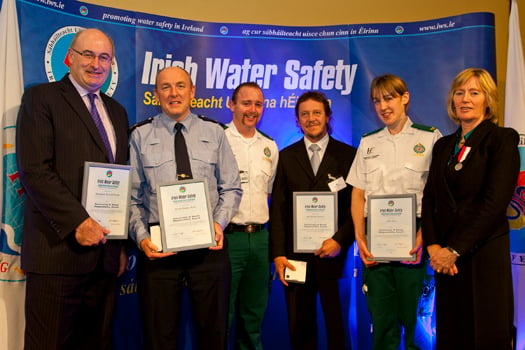
The duo were recognised for going to the aid of nine-year-old Gearóid Rogers, who was caught in a rip current near Spanish Point with his father Ger.
The Rogers family paid tribute to the surfing teens at the ceremony, with Ger saying he and his son were "lucky to be alive" thanks to their actions.
However, from June 30-July 3, when the ships are moored in Waterford and when we do go down to the quays to see them, the public must be aware of the dangers associated with closeness to water and be actively responsible for their own safety and that of their children! No doubt, every precaution will be taken to ensure as far as is practical that safety precautions and rescue equipment are in place for your protection. However, this does not alter the responsibility we have for our own personal safety and that of our children at all times.
For this reason, the host port team for the Tall Ships visit will have in place comprehensive safety and management arrangements, coupled with regimes for rescuing people in the event of a water related accident. Again, this in no way relieves any visitor to the quaysides of responsibility for their own personal water craft and all on board and the safety and care of all.
Therefore:
Do not go too near to the quayside edges; remember falling down between a quay and a boat is one of the most difficult places to get rescued from.
If anxious to see or visit a particular Tall Ship, don't push those in front of you towards the water's edge. Take your time; the ships are in Waterford over three days.
If going on board any boat or ships, never jump from the quay onto the boat, or indeed from boat to boat. Always use a gangplank if available. If not, you must take extreme care when crossing.
Excessive alcohol and water do not mix. Therefore, visitors to the quaysides should ensure that they do not have excessive drink taken.
Those who invite people on board their vessels, regardless of size, must take a responsible approach to the availability of alcohol - bearing in mind the inherent dangers of being on board a vessel at all times under the influence of any alcoholic drink.
Do not climb on or over any railings, walls or other barriers that protect the quays from the water.
On smaller vessels, there is a definite legal requirement in relation to wearing life-jackets and one should be familiar with this requirement.
Ringbuoys and other lifesaving equipment placed on the quaysides should not under any circumstance be interfered with, they are provided to save lives in the event of someone falling into the water.
For those afloat, MARINE NOTICE 047 of 2011 has significance and all should make themselves aware of this important document which covers all recreational craft afloat and the responsibilities with regard to their vessel.
In conclusion, it behoves every person to ensure that The Tall Ships Races will be a safe and memorable occasion to visit Waterford with its noble quays, a once-in-a-lifetime spectacle to have seen and enjoyed by all who visit the city and port.
Calling "112" or "999"- Ask for the "Coast Guard".
If you see someone in trouble in the water (or you think someone is in trouble) don't hesitate to dial one of the emergency numbers (112 or 999) and ask to be put through to the "Coast Guard". When you are connected to the Coast Guard, give a brief description of what you saw and the Coast Guard will decide on the necessary action to take.
Remember! Always ask for the Coast Guard, as this will avoid any unnecessary delay by being connected to the wrong service particularly if someone is in trouble in the water. During the Tall Ships visit to Waterford should a telephone not be available ask any Garda, Civil Defence Officer or other steward on duty for help.
National Water Safety Awareness Week Begins
If you fall overboard, the key to surviving is being able to continue breathing until help arrives. If you are wearing a correctly fitting lifejacket you will stay afloat and breathing. If you are not wearing one and even if you have some swimming ability, you will probably drown, as you grow weaker due to the onset of hypothermia.
As part of National Water Safety Awareness Week (May 30th - June 6th), Irish Water Safety is pushing a new initiative in the hope of reducing the number of boating fatalities. As part of their "Be smart from the start" campaign, Irish Water Safety is pleading with the public to wear their life jacket on a small boat just as they would use a seatbelt in a car.
Carrying a lifejacket on board is simply not good enough. There is no excuse not to wear a life jacket on water, the best lifejacket being the one you will actually wear. Irish Water Safety has launched a new television campaign in the run up to the summer season that is working to convince recreational and commercial boaters to adopt safe practices, particularly the wearing of life jackets. The adverts can be viewed on the IWS website www.iws.ie and on the IWS Facebook and YouTube pages.
Deaths on water are preventable. There are far too many situations in which lifejackets were not considered. Tragically this can often be as a result of not thinking about safety rather than a case of not wanting to do the right thing. Often life jackets sit on boats, unused which is a practice that has to end to save lives.
Here are just some of the tragic circumstances in which people have drowned as a result of not wearing a lifejacket.
- Capsized in rough water.
- Sinking in unexpectedly heavy sea conditions.
- Thrown from the boat as a result of a collision.
- Injured by rocks or submerged objects.
- Tossed into cold water.
- Thrown off balance while fishing.
- Unable to swim because of heavy or waterlogged clothing.
- Wearable lifejackets not readily accessible (locked away or stowed under other gear).
- Not able to put them on quickly in an emergency (vessel sinking, on fire).
- Detailed information on PFD's at http://www.iws.ie/guides-page24421.html
"BE SMART FROM THE START" - Always your lifejacket.



























